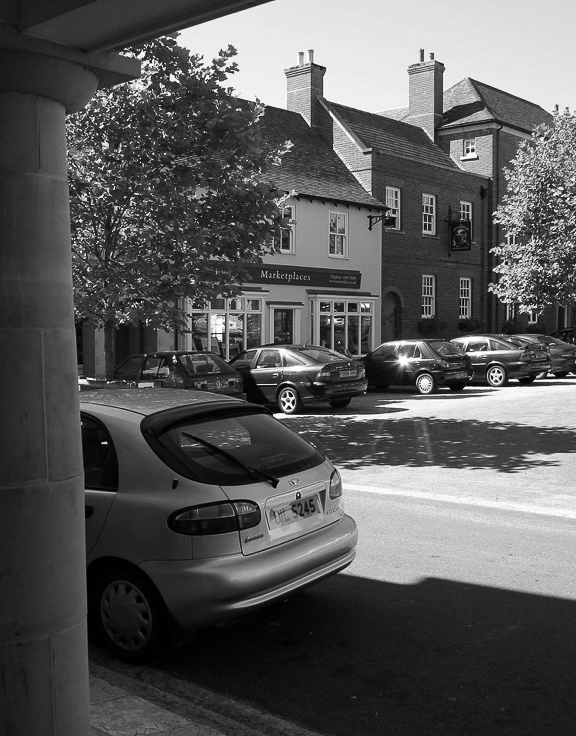19.1. Integrated Affordability
Aus Pattern Language Wiki
One way to maintain Economies Of Place And Differentiation in balance is to avoid clustering affordable housing projects into gigantic “complexes”.
Problem-statement: Large, institutional “affordable housing” buildings — owned by governments or by non-profit companies — have a deeply problematic history. Rather than subsidizing entire buildings or complexes, it is often better to subsidize individual scattered units, or even the people themselves, and allow them to mix into different neighborhoods.
Discussion:The urban extension of Dorchester, UK, known as Poundbury (seen at the start of this pattern) currently maintains an impressive 35% of subsidized, permanently affordable housing — yet it is impossible to tell which unit is affordable and which is “market rate.” Poundbury also offers remarkable diversity of incomes, including wealthy business owners and retirees, all living together with those requiring affordable homes. It supports 2,000 jobs in 80 businesses, meaning that many people have employment opportunities within walking distance of their homes.¹
The practice of scattering affordable homes throughout a neighborhood is known as “pepper-potting,” and it has several clear advantages. First, families requiring affordable homes are not stigmatized by having to live in an identifiable subsidized residence. Second, poverty is not concentrated, avoiding the problem known in the UK as the “sink estate” — an affordable complex where people tend to become trapped, lacking in opportunity. Third, as a result, objections by surrounding neighborhood stakeholders to affordable housing and its perceived impacts is likely to be vastly reduced or nonexistent. Fourth, it is easier to maintain a finer grain and greater variety of dwelling, including different sizes, types and locations to suit different people at different stages of life. This is also beneficial for the variety and complexity of the neighborhood fabric, which is not dominated by large monolithic “social-housing” buildings.
However, there are challenges to this model. First, there are diseconomies of scale in location that have to be managed with careful planning, and met with economies of scale in management procedures. For example, a single agency may “bundle” many units, and consolidate the servicing of the buildings, management, and other functions. Second, the units themselves need to be protected from speculative gains in price. If not, they may become unaffordable even to those with vouchers. There are a number of ways to create these affordability protections, including single agency ownership, a Community Land Trust, a land covenant restricting sales price increases, and similar mechanisms.
In addition, of course, it is essential to remove barriers to affordability from the construction and permitting process itself, including Entitlement Streamlining, and other forms of cost reductions. It is also important to recognize the dynamics of property markets and the need for adequate housing supply, not focused only in the expensive cores but well-distributed across a Polycentric Region.
Therefore:
When providing affordable housing, avoid single-income complexes. Instead, “pepper-pot” units throughout neighborhoods — either managed by non-profit agencies, or sold with controls over the value of the land. Also provide specific targeted subsidies to individuals as needed, and include mechanisms for housing cost reductions.
Use the Community Land Trust and Multi-Family Infill to provide additional sites for affordable homes. …
¹ See https://duchyofcornwall.org/poundbury.html
Mehaffy, M. et al. (2020). INTEGRATED AFFORDABILITY (pattern). In A New Pattern Language for Growing Regions. The Dalles: Sustasis Press. Available at https://pattern-language.wiki/.../Integrated_Affordability
SECTION I:
PATTERNS OF SCALE
1. REGIONAL PATTERNS
Define the large-scale spatial organization…
1.4. 400M THROUGH STREET NETWORK
2. URBAN PATTERNS
Establish essential urban characteristics…
3. STREET PATTERNS
Identify and allocate street types…
4. NEIGHBORHOOD PATTERNS
Define neighborhood-scale elements…
5. SPECIAL USE PATTERNS
Integrate unique urban elements with care…
6. PUBLIC SPACE PATTERNS
Establish the character of the crucial public realm…
7. BLOCK AND PLOT PATTERNS
Lay out the detailed structure of property lines…
8. STREETSCAPE PATTERNS
Configure the street as a welcoming place…
9. BUILDING PATTERNS
Lay out appropriate urban buildings…
10. BUILDING EDGE PATTERNS
Create interior and exterior connectivity…
10.1. INDOOR-OUTDOOR AMBIGUITY
SECTION II:
PATTERNS OF MULTIPLE SCALE
11. GEOMETRIC PATTERNS
Build in coherent geometries at all scales…
11.2. SMALL GROUPS OF ELEMENTS
12. AFFORDANCE PATTERNS
Build in user capacity to shape the environment…
13. RETROFIT PATTERNS
Revitalize and improve existing urban assets …
14. INFORMAL GROWTH PATTERNS
Accommodate “bottom-up” urban growth…
15. CONSTRUCTION PATTERNS
Use the building process to enrich the result…
SECTION III:
PATTERNS OF PROCESS
16. IMPLEMENTATION TOOL PATTERNS
Use tools to achieve successful results…
16.2. ENTITLEMENT STREAMLINING
16.3. NEIGHBORHOOD PLANNING CENTER
17. PROJECT ECONOMICS PATTERNS
Create flows of money that support urban quality…
17.4. ECONOMIES OF PLACE AND DIFFERENTIATION
18. PLACE GOVERNANCE PATTERNS
Processes for making and managing places…
18.3. PUBLIC-PRIVATE PLACE MANAGEMENT
19. AFFORDABILITY PATTERNS
Build in affordability for all incomes…
19.1. INTEGRATED AFFORDABILITY
20. NEW TECHNOLOGY PATTERNS
Integrate new systems without damaging old ones…
20.2. RESPONSIVE TRANSPORTATION NETWORK COMPANY

